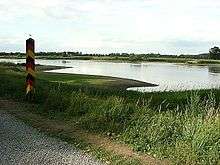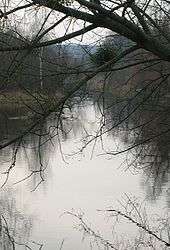Oder
| Oder (Odra) | |
| River | |
| Oder between Kienitz and Zollbrücke, Germany | |
| Countries | Czech Republic, Poland, Germany |
|---|---|
| Source | |
| - location | Fidlův kopec, Oderské vrchy, Nízký Jeseník, Olomouc District, Olomouc Region, Moravia, Czech Republic |
| - elevation | 634 m (2,080 ft) |
| - coordinates | 49°36′47″N 017°31′15″E / 49.61306°N 17.52083°E |
| Mouth | Szczecin Lagoon |
| - location | Baltic Sea, Poland |
| - coordinates | 53°40′19″N 14°31′25″E / 53.67194°N 14.52361°ECoordinates: 53°40′19″N 14°31′25″E / 53.67194°N 14.52361°E |
| Length | 854 km (531 mi) |
| Basin | 118,861 km2 (45,892 sq mi) |
| Discharge | mouth |
| - average | 574 m3/s (20,271 cu ft/s) |
 | |





The Oder (German pronunciation: [ˈoːdɐ]; Czech, Lower Sorbian and Polish: Odra, Upper Sorbian: Wódra)[1] is a river in Central Europe. It rises in the Czech Republic and flows (generally north- and northwest-ward) through western Poland, later forming 187 kilometres (116 mi) of the border between Poland and Germany, part of the Oder–Neisse line. The river ultimately flows into the Szczecin Lagoon north of Szczecin and then into three branches (the Dziwna, Świna and Peene) that empty into the Gulf of Pomerania of the Baltic Sea.
Names
The Oder is known by several names in different languages, but the modern ones are very similar: English and German: Oder; Czech, Polish, and Lower Sorbian: Odra, Upper Sorbian: Wódra; Kashubian: Òdra (pronounced [ˈwɛdra]); Medieval Latin: Od(d)era; Renaissance Latin: Viadrus (invented in 1534).
Ptolemy knew the modern Oder as the Συήβος (Suebos; Latin Suevus) – a name apparently derived from the Suebi, a Germanic people. While he also refers to an outlet in the area as the Οὐιαδούα Ouiadoua (or Οὐιλδούα Ouildoua; Latin Viadua or Vildua), this was apparently the modern Wieprz, as it was said to be a third of the distance between the Suebos and Vistula.[2][3] The name Suebos may be preserved in the modern name of the Świna river (German Swine) – an outlet from the Szczecin Lagoon to the Baltic.
In the Old Church Slavonic language, the name of the river is Vjodr.[4]
Geography
The Oder is 854 kilometres (531 miles) long: 112 km (70 miles) in the Czech Republic, 742 km (461 miles) in Poland (including 187 km (116 miles) on the border between Germany and Poland) and is the second longest river in Poland (after the Vistula). It drains a basin of 118,861 square kilometres (45,892 sq mi), 106,056 km2 (40,948 sq mi) of which are in Poland (89%), 7,217 km2 (2,786 sq mi) in the Czech Republic (6%), and 5,587 km2 (2,157 sq mi)in Germany (5%). Channels connect it to the Havel, Spree, Vistula system and Kłodnica. It flows through Silesian, Opole, Lower Silesian, Lubusz, and West Pomeranian voivodeships of Poland and the states of Brandenburg and Mecklenburg-Vorpommern in Germany.
The main branch empties into the Szczecin Lagoon near Police, Poland. The Szczecin Lagoon is bordered on the north by the islands of Usedom (west) and Wolin (east). Between these two islands, there is only a narrow channel (Świna) going to the Bay of Pomerania, which forms a part of the Baltic Sea.
The largest city on the Oder is Wrocław, in Lower Silesia.
Navigation
The Oder is navigable over a large part of its total length, as far upstream as the town of Koźle, where the river connects to the Gliwice Canal. The upstream part of the river is canalized and permits larger barges (up to CEMT Class IV) to navigate between the industrial sites around the Wrocław area.
Further downstream the river is free flowing, passing the towns of Eisenhüttenstadt (where the Oder–Spree Canal connects the river to the Spree in Berlin) and Frankfurt upon Oder. Downstream of Frankfurt the river Warta forms a navigable connection with Poznań and Bydgoszcz for smaller vessels. At Hohensaaten the Oder–Havel Canal connects with the Berlin waterways again.
Near its mouth the Oder reaches the city of Szczecin, a major maritime port. The river finally reaches the Baltic Sea through the Szczecin Lagoon and the river mouth at Świnoujście.[5]
History
The river in Germania Magna was known to the Romans as the Viadrus or Viadua in Classical Latin,
as it was a branch of the Amber Road from the Baltic Sea to the Roman Empire (see via). In German language it was and is called the Oder, written in older records as Odera or Oddera in Medieval Latin documents. It was mentioned in the Dagome iudex, which described territory of the Duchy of Poland under Mieszko I of Poland ca. 990, as a part of duchies western frontier.
Before Slavs settled along its banks, Oder was an important trade route and towns in Germania were documented along with many tribes living between the rivers Albis (aka Elbe), Oder and Vistula. Centuries later, after Germanic tribes were long gone, the Bavarian Geographer (ca. 845) specifies the following West Slavic peoples: Sleenzane, Dadosesani, Opoloni, Lupiglaa, and Gоlеnsizi in Silesia and Wolinians and Pyrzycans in Western Pomerania. A document of the Bishopric of Prague (1086) mentions Zlasane, Trebovyane, Poborane, and Dedositze in Silesia.
In the 13th century, the first dams were built to protect agricultural lands.
The Finow Canal, built for the first time in 1605, connects Oder and Havel. After completion of the more straight Oder–Havel Canal in 1914, its economic relevance decreased.
The earliest important undertaking with a view of improving the waterway was due to the initiative of Frederick the Great, who recommended the diversion of the river into a new and straight channel in the swampy tract of land known as Oderbruch near Küstrin. The work was carried out in the years 1746–53, a large tract of marshland being brought under cultivation, a considerable detour cut off and the main stream successfully confined to a canal.
In the late 19th century three additional alterations were made to the waterway:
- The canalization of the main stream at Breslau, and from the confluence of the Glatzer Neisse to the mouth of the Klodnitz Canal, a distance of over 50 miles (80 km). These engineering works were completed in 1896.
- During 1887–91 the Oder–Spree Canal was made to connect the two rivers named.
- The deepening and regulation of the mouth and lower course of the stream.
By the Treaty of Versailles the navigation on the Oder became subject to International Commission of the Oder.[6] Following the articles 363 and 364 of the Treaty Czechoslovakia was entitled to lease in Stettin (now Szczecin) its own section in the harbour, then called Tschechoslowakische Zone im Hafen Stettin.[7] The contract of lease between Czechoslovakia and Germany, and supervised by the United Kingdom, was signed on February 16, 1929, and would end in 2028, however, after 1945 Czechoslovakia did not regain this legal position, de facto abolished in 1938–39.
At the 1943 Tehran Conference the allies decided that the new Eastern border of Germany would run along the Oder[8] but after World War II, the Oder and the Lusatian Neisse formed the Oder–Neisse line, which was designated by the victorious allies at the Potsdam Conference as the new border between Poland and Germany. A significant percentage of the German populations east of these two rivers were evacuated by the Nazis or fled before the approaching Red Army. After the war, the remaining population was forcibly expelled in accordance with the Potsdam Agreement.[9] East Germany confirmed the border with Poland in 1950, then West Germany, after a period of refusal, finally accepted the border in 1970. In 1990 newly reunified Germany and the Republic of Poland signed a treaty recognizing it as their border.
Cities
Main section:
- Ostrava – Bohumín – Racibórz – Kędzierzyn-Koźle – Krapkowice – Opole – Brzeg – Oława – Jelcz-Laskowice – Wrocław – Brzeg Dolny – Ścinawa – Szlichtyngowa – Głogów – Bytom Odrzański – Nowa Sól – Krosno Odrzańskie – Eisenhüttenstadt – Frankfurt (Oder) – Słubice – Kostrzyn – Cedynia – Schwedt – Vierraden – Gartz – Gryfino – Szczecin – Police
Dziwna branch (between Wolin Island and mainland Poland):
Świna branch (between Wolin and the Usedom islands):
Szczecin Lagoon:
Peene branch (between Usedom Island and the German mainland):
Eastern tributaries
- Ostravice – Olza – Raude – Bierawka – Kłodnica – Czarnka – Mała Panew – Stobrawa – Widawa – Jezierzyca – Barycz – Krzycki Rów – Obrzyca – Jabłonna – Pliszka – Ołobok – Gryżynka – Warta with the Noteć – Myśla – Kurzyca – Stubia – Rurzyca – Tywa – Płonia – Ina – Gowienica - Śmieszka
Western tributaries
- Opava – Psina (Cyna) – Cisek – Olszówka – Stradunia – Osobłoga – Prószkowski Potok – Nysa Kłodzka – Oława – Ślęza – Bystrzyca – Średzka Woda – Cicha Woda – Kaczawa – Ślepca – Zimnica – Dębniak – Biała Woda – Czarna Struga – Śląska Ochla – Zimny Potok – Bóbr – Olcha – Racza – Lusatian Neisse – Finow – Gunica
Notes
- ↑ Czech pronunciation: [ˈodra], Polish pronunciation: [ˈɔdra]
- ↑ Claudius Ptolemaios: Geographike Hyphegesis, Kap. 11: Germania Magna. (altgriech./lat./engl.)
- ↑ Ralf Loock: Mündungen der Flüsse bestimmt. In: Märkische Oderzeitung, Frankfurt 2008,3 (März); Ralf Loock: Namenskrimi um Viadrus in: Märkische Oderzeitung – Journal. Frankfurt 25./26. Nov. 2006, S. 2; siehe auch Alfred Stückelberger, Gerd Graßhoff (Hrsg.): Ptolemaios – Handbuch der Geographie. Schwabe, Basel 2006, S. 223, ISBN 3-7965-2148-7
- ↑ Encyclopædia Britannica's 9th edition 1870–1890: Oder&
- ↑ NoorderSoft Waterways Database Archived November 9, 2005, at the Wayback Machine.
- ↑ The commission was staffed with one representative of Czechoslovakia, Denmark, France, Poland, Sweden, and the United Kingdom each and three representatives of Prussia, being the German state competent for the navigable section of the Oder, comprised within the latter's borders. Cf. Der Große Brockhaus: Handbuch des Wissens in zwanzig Bänden: 21 Bde., completely revised ed., Leipzig: F. A. Brockhaus, 151928-1935, vol 13 (1932): Dreizehnter Band Mue–Ost, article: 'Oder', pp. 600seq., here p. 601. No ISBN.
- ↑ Cf. Archiwum Państwowe w Szczecinie (State Archive of Szczecin), Rep. 126, Krajowy Urząd Skarbowy w Szczecinie
- ↑ Allen DJ (2003) The Oder-Neisse line: the United States, Poland, and Germany in the Cold War, Praeger P13
- ↑ XII. ORDERLY TRANSFER OF GERMAN POPULATIONS.The Three Governments, having considered the question in all its aspects, recognize that the transfer to Germany of German populations, or elements thereof, remaining in Poland, Czechoslovakia and Hungary, will have to be undertaken. They agree that any transfers that take place should be effected in an orderly and humane manner.
See also
| Wikimedia Commons has media related to Oder River. |
- List of rivers of Germany
- List of rivers of Poland
- Lower Oder Valley National Park
- Oder–Neisse line
- Odra Wodzisław
- Ostrów Grabowski, a river island in Szczecin
External links
- multilingual information site on the Oder
- Odra electronic shipping guide
- Bibliography on Water Resources and International Law Peace Palace Library
![]() This article incorporates text from a publication now in the public domain: Chisholm, Hugh, ed. (1911). "article name needed". Encyclopædia Britannica (11th ed.). Cambridge University Press.
This article incorporates text from a publication now in the public domain: Chisholm, Hugh, ed. (1911). "article name needed". Encyclopædia Britannica (11th ed.). Cambridge University Press.